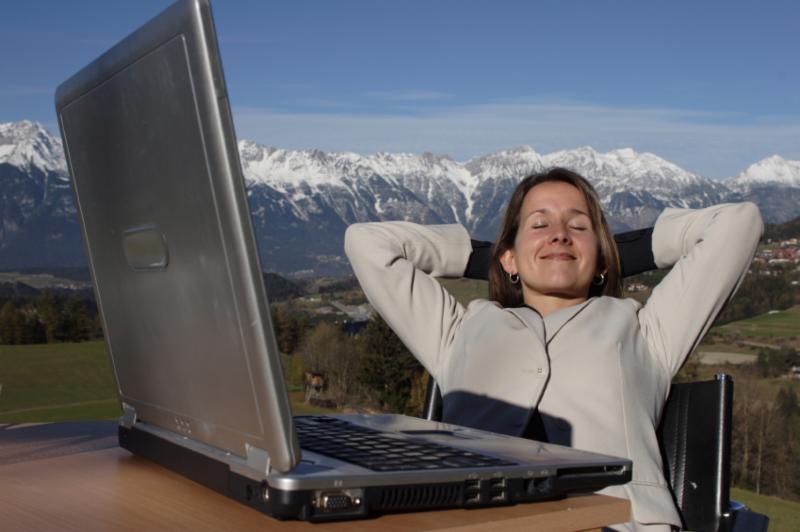Getting your home or business office organized requires considering all aspects of your office and making them more efficient. When you can function efficiently, your productivity goes up and your stress goes down! There are several key areas that, when organized and set up properly, will make your office easier to use and save you time and effort.
1. Furniture Layout:
When you sit at your desk, you want everything you use regularly to be within reach. For your office furniture, an L- or U-shaped layout enables you to just turn in your chair and access often-used filing cabinets, workspace or bookshelves. Another alternative is to float your desk away from the wall and put things like filing cabinets and bookshelves against the wall behind you. However you decide to arrange your office, think about what you need to access most often and minimize the effort you need to use to get to it. If you have to get up and walk across the room every time you need to grab a reference binder, find a file, or to use your shredder, you’re wasting time and energy. And even more crucial to keeping your office organized is the effort it takes to put something away when you’re done with it! If you have to make too much effort to file that paper or put that binder away, it’s more than likely you won’t bother, leaving the piles to accumulate again.
2. Desk
Your desk should also be a place where you keep what you use most often within easy access. If you reach for it multiple times a day (stapler, pens, paper clips, note pad, etc.) it should make its home on top of your desk. A vertical file sorter or desktop file box can hold current project files and regularly used reference materials. Keeping the top of your desk free of excess stuff makes it easier to find what you want when you need it and reduces visual clutter, which can be distracting. It’s also helpful to keep some surface space open so you have room to stretch out while you work. Otherwise, use your desk drawers to store a few of the smaller back up supplies for the stuff you keep on top of your desk (paper clips, staples, etc.) and the things you use more than a few times a week.
3. Supply Storage
All of the extra supplies that you keep on hand – reams of paper, toner, ink cartridges, boxes of pens, etc., belong in a separate area away from your desk. Either a closet or set of shelves placed higher up on the wall can hold those seldom-needed supplies in baskets or bins. If your office is small with limited floor space, consider your vertical space. Hanging shelves all the way up to the ceiling will keep stuff off the floor and gain you much-needed storage space for those extra supplies.
4. Filing Cabinets
Most of us keep far more paper than we need. Statistics show that 80% of what we file never gets looked at again. The average household really only needs 2-4 file drawers to keep its household paperwork, unless you are running a home-based business or have unusual circumstances, such as family members with medical issues that may require keeping more paperwork. Store documents that you need to keep for long periods of time but don’t need to access often (like previous years’ tax records) in banker’s boxes in an out-of-the-way place, such as an attic, a (dry) basement, garage, or storage closet. Purge your paperwork at least once a year to keep the volume down, and carefully consider if you need to keep something before you just automatically file it.
Ask yourself 3 questions:
- How difficult would it be to retrieve this information if I needed it again?
- Can I reliably get this information from another source (i.e. online)?
- What would be the worst thing that would happen if I threw it away?
5. Lighting & Chairs
One of the things I notice most often in my clients’ home offices is that they hate working there because the lighting is poor, or they’re making do with an old, uncomfortable chair. They end up working in other, more comfortable places in their home. This means that they don’t have the supplies and reference materials they need close at hand to get their work done efficiently. In addition, often those family gathering spaces become cluttered with work papers and materials, not only creating more clutter in their living spaces, but also making it more difficult to find what they need when they need it because the stuff never makes it back to its home in the office. Every office, home or business, needs both ambient lighting that illuminates the entire room, and task lighting, which targets your desk and workspace. And for heaven’s sake – if you’re spending a lot of time at your desk, get yourself a comfortable chair! You will feel better, concentrate more effectively, and increase your productivity so you can get out of that office sooner!
Creating an organized, functional physical work environment is crucial to keeping you productive and stress-free. It leaves you more time and energy to do the things you really enjoy – whether that’s leisure activities, time with your family, or even doing more work that you find truly rewarding!


